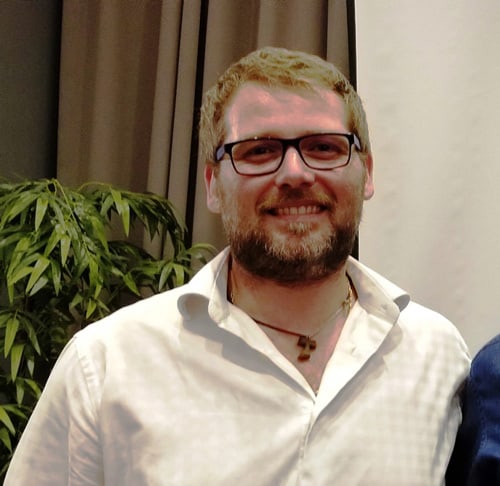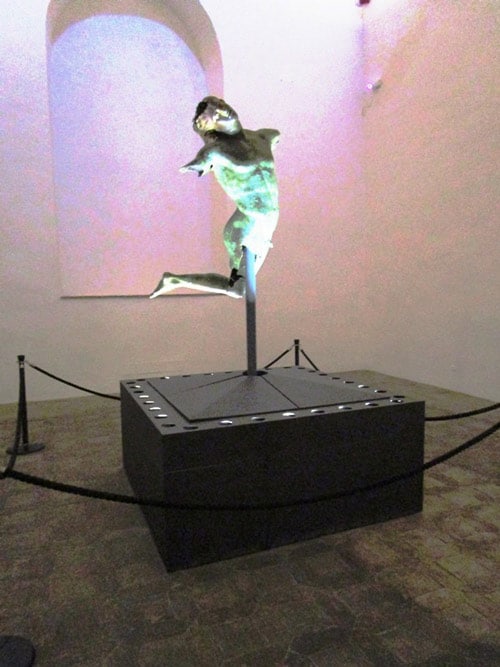

It happens all the time with Overseas Adventure Travel. I start out expecting to write about the trip itself ― in this case, Sicily’s ancient landscapes and timeless traditions ― and I end up writing about all the things that are not on the itinerary ― what OAT refers to as Learning and Discovery. Sure, I wanted to focus on the extensive ruins of the Greeks and Romans from the eighth century B.C. and the city market initiated by the Arabs in 900 A.D. which still operates today almost as it did then.
The Norman Church was built in 1174 which was proclaimed by acclamation of the trip participants as “The most magnificent cathedral ever!” and a boat ride to a Phoenician island dating back 2,700 years. And that barely brushes the surface of the extensive itinerary that brought new adventures to our group of 16, day after day. But that’s where the story veered into trouble…

I found myself being equally surprised and delighted by all the little extra things we were seeing and doing ― and yes, often eating ― that were not on the itinerary, the L&D moments that reflect the culture and deepen the immersive experience already embodied within the OAT itinerary, but which differ for every trip. You will probably not experience what I did, but you will be enamored by whatever you do.
OAT’s Emphasis on Learning and Discovery Adds a Whole New Dimension to Their Itineraries
While exploring the capital city of Palermo, we stopped at a tiny, nondescript storefront with antique-looking sewing machines and irons but okay, the owner is a tailor. How then to explain all the old instruments strewn everywhere? The tailor is also a musician. He sang along as he played a 50-year-old mandolin.
Come for repairs; stay for the repertory…
Such an OAT moment, which places a great deal of attention on offering off-beat examples of local culture that are nowhere on the itinerary.

As soon as we arrived in Castelbuono, a 14th-century medieval village whose history dates back to the Arab influence of the 800’s, it was time for another discovery: a variety of Sicilian pastries washed down with samples of liqueurs ranging from Lemon, cinnamon to tangerine and prickly pear.
By this time, it was hard for me to work up an interest in the surrounding history, usually a passion of mine. Stopping for a “taste” can translate into a marathon multi-course mini-meal. So yes, often L&D has to do with food which is understandable: aside from the Mafia, food is what Sicily is known for.
Because another OAT philosophy is its emphasis on controversial topics, a discussion of the Mafia was not unexpected. Meeting with Angelo Provenzano, the son of one of the most notorious Mafia bosses in Sicilian history from 1993-2006, was.

Kept in hiding for the first 16 years of his life, Provenzano recounted the difficulty of separating his feelings for his father from his feelings about his father and the impossibility of leading a normal life despite his having no connection with the Mafia himself.
It should come as no surprise that the Cosa Nostra is still alive and well in Sicily but not to the level that a Godfather IV is anywhere in production. In response to a question as to the accuracy of those films, Angelo replied, “Except for certain Hollywood effects, the films are basically realistic.”
And as for Angelo’s birthplace? The city of Corleone, of course. A name everyone in the room knew well.

Marzipan in Sicily, Italy
Knowing that Sicily is known for marzipan, a favorite almond paste treat of mine, I asked our guide, Alessio where best to buy it. He sheepishly said, “We’ll find some.”
Ten minutes later, at a small Benedictine cathedral built in 1092 where nuns had been preparing pastry for years, the following story unfolded: one year the Pope was coming to visit but being winter there were no fruits on the trees, so the nuns made little fruits out of marzipan and hung them on the trees.
Today, a group of cloistered Benedictine nuns still prepare such offerings which are only retrievable through a small mesh door that revolves to reveal its marzipan delicacies. As responsive as I knew Alessio to be to special requests, I thought, “Nah, he couldn’t possibly have had enough time to set that up.”

History, Culture and Off-beat Attractions Abound in OAT’s Trip to Sicily, Italy
In a local museum in Mazara, we viewed the Dancing Satyr, a Greek bronze statue from the third century B.C. that was pulled from the sea in 1998 in the nets of some fishermen.
As fascinating as the story was ― an archaeological event that captured the attention of the world ― it didn’t compare with the unexpected meeting with the boat captain who made the discovery. His personal story was even more enthralling.

Picnic lunches are not unusual on tours. But when they take place on an island settled by Phoenicians some 2,700 years ago ― one of the largest remains of Phoenician ruins in the world ― and your picnic table is made out of a stone from one of their former structures, the picnic takes on slightly greater significance.

Roman and Greek Temple Remains in Italy
Not to be outdone by the Phoenicians, the Romans and Greeks want equal time – so on to the Valley of Temples. 50,000 Greeks lived here 2,600 years ago, and the remains of multiple temples constitute the second-largest archaeological site in the world. One of the temples remains intact, while others have been reconstructed from original materials.
It’s so hard to fathom that anything can survive that long. And then the Romans came in 600 A.D. and built their own structures on top of the Greek ones. And they, too, survived.
Our local guide stopped to pick up what to me looked like a number of rocks which he then identified as a rooftop tile and a piece of pottery or a jug. Just lying there. Still. After 2,600 years. Sometimes itinerary items are pretty cool, too.
By the end of the trip, after visiting sites representing Roman, Greek, Norman, Arabic, Carthaginian, Phoenician, Byzantine and Spanish occupation ― and I’m sure I’ve left some out ― we arrived in Syracusa, an ancient city that boasted remnants of all of them. There were ruins from everyone everywhere.
During the boat ride around the island of Ortigia, we sampled some Sicilian almond liqueur to get us through the 40-minute excursion. And why not? Just another L&D surprise. Who said alcohol can’t be part of a cultural experience?
Narrow Roads and Fiats in Sicily
Admittedly, exploring the old Medieval city of Modica was fascinating, but it couldn’t compare with the unexpected joy rides in vintage iconic Fiat 500 sports cars over hilly, twisty, curvy, windy, narrow, cobblestone streets. First made popular in 1957 as a readily affordable automobile, these refurbished convertibles, which are smaller than Smart cars, still barely fit in alleyways that were unfathomably two-way.
Warning: “Do not put your hand outside the car or you’ll end up losing it.” Sort of like a Disney ride threatening to go off the tracks. The fact that we were driving through a former 12th century Norman city was just a bonus.

Renacting History in Sicily, Italy
Another itinerary highlight worth mentioning is the Landing Museum, a moving testament to the end of Italy’s involvement in World War II. I tend to forget that Italy, a fascist nation, actually fought on the side of Germany and we invaded in 1943, effectively ending Mussolini’s rule.
Upon entering a replica of a Catania street in the 1940s, we suddenly heard an air raid siren and were quickly ushered into the bomb shelter before the door closed. That was all the time we had if we wanted to live.
Then for the next minute and a half planes shrieked, bombs dropped, dogs barked and we could hear the hysterical cries of anxious people ― in real life these things actually went on for hours. The shelter shook and as much as I knew this was only a simulation, I could still feel the terror of those who had to endure such trauma day after day for years. We emerged to find ourselves surrounded by rubble.
The rest of the museum accurately relates the people and events who suffered through this sad part of Italy and Sicily’s history. And indeed it was nice to hear how welcome the Allied forces were once they arrived.

Because OAT thrives on controversy, we met with members of an organization that aids young immigrant girls who illegally land in Sicily, where a sign on the port declares “Welcome Refugees.”
“Oh how much we could learn from this small island,” I thought. And it was harrowing to listen to 19-year-old Joyce’s story of being lured from her home and family in Nigeria with promises of education in Europe only to find herself part of an agonizing nine-month ordeal spent in many refugee camps in Libya and Syria along the way under abusive, horrendous conditions as a part of a sex-and-drug trafficking operation.
Fortunately, she was saved by the Casa di Maria organization upon her arrival in Sicily, most are not. No one exited that room without feeling emotionally drained. Again.
OAT’s Regular Itinerary Enhanced by Their L&D Adventures Make for an Unequaled Exploration of Sicily, Italy
And then there’s Mt. Etna – at over 10,000 feet, the largest active volcano in Europe. Although the last eruption was in May 2017, we were repeatedly assured we were in no danger of a repeat.
As a hiker, I’m used to climbing over rocks and roots. But this was my first experience with lava stones and fields ― a topography I had never seen before. As we climbed the almost two miles, we passed two centuries’ worth of vegetation from tiny tufts of green still recovering from earlier eruptions to huge, long-standing pine trees of old.
I’m a travel writer and I’m supposed to be able to bring experiences to life but this was so surreal, other-worldly, so without comparison to anything I’ve seen before that I feel inadequate to capture it in mere words. A stop afterward for a shot of Etna Fire ― a 70-proof alcoholic concoction ― shook me out of my volcanic revelry.

After our Farewell Dinner, it was hard to believe there would be another L&D moment. After all, it was late and we all had early flights the next day. But we headed into town to a small, stand-alone outdoor shack where the vendor ― more a bartender, even more, a mixologist ― mixed up drinkable art.
The drink consisted of tamarind syrup, freshly squeezed lemon, soda water and then the piece de resistance, baking soda. All shaken up with gusto.
The whole point? To make you burp. A lot. A Sicilian tradition. A very successful Sicilian tradition.
Who wouldn’t want to go on such a tour? For more information, visit OAT Travel online.

